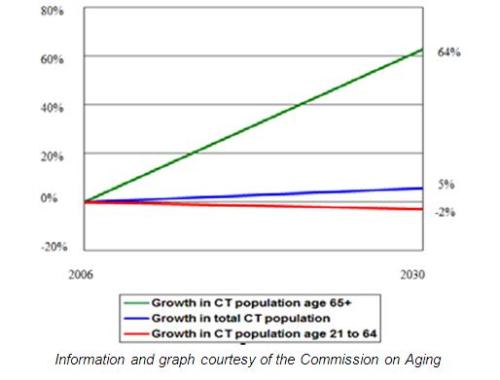Guest Post by Deb Werner, Director of Member Services, Connecticut Council for Philanthropy
In January 2011, the Council joined the EngAGEment Initiative, becoming one of 16 regional associations participating in this program with Grantmakers in Aging (GIA). While the Council had been invited to join the EngAGEment Initiative when it originated, and again a few years ago, it was not until recently that the emerging “age wave” finally appeared on the radar screen of the Connecticut philanthropic community and our members.
The Council’s goal, supported by a Leadership Team composed of Council members, is to increase awareness and encourage funders to take an active interest in aging issues in their communities, and use their convening power, influence, knowledge and resources to assist in finding creative solutions.
To determine Connecticut funders’ “aging” awareness and activities, the Council developed a baseline survey which was distributed to members and non-member funders. We learned that funding aging issues is an organizational priority from 31% of the responders and that aging is not included in their grantmaking from 26% of responders. Another 41% reported that they’re likely to fund programs for older adults within the next 3 years. Clearly these low response rates in June 2011 indicated there was limited interest in this funding area and that we had much to do. (To read a summary of survey results, please click here.)
Connecticut Statistics:
- Connecticut has more than 472,000 residents over the age of 65 (US Census Bureau).
- Connecticut is the 7th oldest state in the nation.
- Connecticut’s older adult population is expected to increase by 64% from 2006 to 2030.
 Looking to focus attention on this issue, the Council hosted three programs in 2011 to expose grantmakers to the changing profile of the state’s growing older population, and the issues inherent with the aging population, and illustrate that the issues many funders already address – health care service, housing, and transportation are central to the growing aging sector.
Looking to focus attention on this issue, the Council hosted three programs in 2011 to expose grantmakers to the changing profile of the state’s growing older population, and the issues inherent with the aging population, and illustrate that the issues many funders already address – health care service, housing, and transportation are central to the growing aging sector.
The programs included:
Connecticut’s Aging Population – State and Federal Perspectives. Grantmakers learned about challenges and opportunities affecting Connecticut’s growing aging population, and heard about the priorities and resources the State is currently providing. The presenters shared information about the work of Federal, State and regional agencies and discussed the services and resources available to support this sector of the population.
Connecticut’s Aging Population – Nonprofit Organizations Serving Older Adults. Grantmakers learned from the nonprofit service provider perspective about the needs of residents age 60 and older. They focused on the challenges and issues confronting nonprofits and their clients, gaps in services and promising practices. Presenters discussed the readiness of nonprofits to serve aging residents of the state and how private philanthropy can make a difference.
Aging Ready Communities – Challenges, Opportunities, National and Local Models. Aging in place experts, Philip B. Stafford, Ph.D., Director of the Center on Aging and Community at Indiana Institute on Disability and Community at Indiana University, and Mia Oberlink, M.A., Project Director, Community Innovations for Aging in Place Initiative TAG Team and Senior Research Associate for the Center for Home Care Policy and Research, Visiting Nurse Services of New York, shared their insight and knowledge about the positive influences, productive potential and health benefits of aging-ready communities. Representatives from grantmaking organizations, nonprofit providers, state and community agencies, and experts from colleges and universities, engaged in a lively conversation about aspects of livable, inclusive communities, the positive benefits of older adults aging in their communities, the critical relationships between mobility and housing, land use decision making, and the need to “raise the volume” on the relationship between older individuals and their surrounding environment.
By year’s end, the Council saw increased recognition by grantmakers of the impending impact of the aging population on communities in Connecticut. With one more year’s participation in the EngAGEment Initiative remaining, we hope the aging issue will be considered in funding priorities or as a component of existing priorities by an increasing number of grantmakers.
Discussion for the direction of our 2012 programming and learning areas revolves around expanding the visibility of the aging population by illustrating the points of connection with the human services sector. The Leadership Team expressed interest in considering “core standards” – identifying and categorizing how nonprofits are connecting aging citizens to information and services, thus enabling them to remain in their homes and be active members of their community – as a guideline for aligned grantmaking. This focus also provides potential for connecting aging issues more directly with other grantmaking priorities.
While considerably more conversation is needed, it’s clear that members of the Leadership Team have engaged their individual organizations in new discussions about their involvement and grantmaking in this area. The Council aims to do the same with our entire membership.
You may follow the work of the EngAGEment Initiative and access important aging information and resources on our website.


